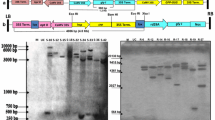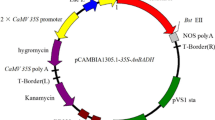Abstract
l-Galactono-1, 4-lactone dehydrogenase (GalLDH; EC 1.3.2.3) is the last key enzyme in the putative l-ascorbic acid (AsA) biosynthetic pathway of higher plants. To evaluate the effect of the gene on manipulating AsA accumulation, a cDNA encoding GalLDH (RrGalLDH, Acc. No. AY643403), isolated from Rosa roxburghii fruit known to be rich in AsA, was introduced into tobacco plants by Agrobacterium-mediated transformation under CaMV 35S constitutive promoter in the present study. Southern blotting revealed the stable integration of the transgene with single copy in four independent transgenic lines, among which, L3 and L4 showed the significantly enhanced RrGalLDH transcript levels, GalLDH activities and AsA accumulations as compared to untransformed (WT) plants. So, we developed the AsA-overproducing tobacco plant by overexpressing GalLDH. As exposed to salt stress (100 mM NaCl), these AsA-overproducing transgenic lines were found to grow better with increased shoot length and fresh weight than WT. Furthermore, L3, which demonstrated the highest AsA accumulation (2.1-fold higher than WT) and expression level of RrGalLDH, showed a higher resistance to oxidative stress caused by paraquat when compared to WT. These results further justify that the overexpression of GalLDH gene confers an elevated AsA accumulation and tolerance against environmental stresses.





Similar content being viewed by others
References
Agius F, Gonzlezolez LR, Caballer JL (2003) Engineering increased vitamin C levels in plants by over- expression of a d-galacturonic acid reductase. Nat Biotechnol 21:177–181
Alhagdow M, Mounet F, Gilbert L, Nunes-Nesi A, Garcia V, Just D, Petit J, Beauvoit B, Fernie AR, Rothan C (2007) Silencing of the mitochondrial ascorbate synthesizing enzyme l-galactono-1,4-lactone dehydrogenase affects plant and fruit development in tomato. Plant Physiol 145:1408–1422
An HM, Chen LG, Fan WG (2004) cDNA fragment cloning of l-galactono-1, 4-lactone dehydrogenase and its expression in different organs of R. roxburghii Tratt. Agri Sci in China 11:807–811
An HM, Fan WG, Chen LG, Asghar S, Liu QL (2007) Molecular characterisation and expression of l-galactono-1,4-lactone dehydrogenase and l-ascorbic acid accumulation during fruit development in Rosa roxburghii. J Hortic Sci Biotech 82:627–635
Arrigoni O, de Tullio MC (2002) Ascorbic acid: much more than just an antioxidant. Biochem Biophys Acta 1569:1–9
Badawi GH, Kawano N, Yamauchi Y, Shimada E, Sasaki R, Kubo A, Tanaka K (2004) Over-expression of ascorbate peroxidase in tobacco chloroplasts enhances the tolerance to salt stress and water deficit. Physiol Plant 121:131–238
Bartoli CG, Pastori GM, Foyer CH (2000) Ascorbate biosynthesis in mitochondria is linked to the electron transport chain between complexes III and IV. Plant Physiol 123:335–343
Bauw GJC, Davey MW, Ostergaard J, Van Montagu MCE (2002) Production of ascorbic acid in plants. US Patent 6,469,149
Bulley S, Rassam M, Hose D, Otto W, Schunemann N, Wright M, Macrae E, Gleave A, Laing W (2009) Gene expression studies in kiwifruit and gene over-expression in Arabidopsis indicates that GDP-L-galactose guanyl transferase is a major control point of vitamin C biosynthesis. J Exp Bot 60:765–778
Bulley S, Wright M, Rommens C, Yan Hua, HuaYan M, Wang KL, Andre C, Brewster D, Karunairetnam S, Allan AC, Laing WA (2011) Enhancing ascorbate in fruits and tubers through over-expression of the L-galactose pathway gene GDP-L-galactose phosphorylase. Plant Biotechnol J 10:390–397
Chang SJ, Jeff P, John C (1993) A simple and efficient method for isolating RNA from pine trees. Plant Mol Biol Rep 11:113–116
Chen Z, Young TE, Ling J, Chang SC, Gallie DR (2003) Increasing vitamin C content of plants through enhanced ascorbate recycling. Proc Natl Acad Sci USA 100:3525–3530
Citterio S, Sgorbati S, Scippa S, Sparvoli E (1994) Ascorbic acid effect on the onset of cell proliferation in pea root. Physiol Plant 92:601–607
Conklin PL (2001) Recent advance in the role and biosynthesis of ascorbic acid in plants. Plant Cell Environ 24:383–394
Conklin PL, Barth C (2004) Ascorbic acid, a familiar small molecule intertwined in the response of plants to ozone, pathogens, and the onset of senescence. Plant Cell Environ 27:959–970
Davey MW, Montagu VM, Inzh D, Sanmartin M, Kanellis A (2000) Plant l-ascorbic acid: chemistry, function, metabolism, bioavailability and effects of processing. Sci Food Agric 80:825–860
Eltayeb A, Kawano N, Badawi G, Kaminaka H, Sanekata T, Shibahara T, Inanaga S, Tanaka K (2007) Overexpression of monodehydroascorbate reductase in transgenic tobacco confers enhanced tolerance to ozone, salt and polyethylene glycol stresses. Planta 225:1255–1264
Fan WG, Xia GL, Luo YC (1997) Utilization of Rosa roxburghii resources and its development strategy in Guizhou province. Southwest China. J Agric Sci 10:109–115
Gatzek S, Wheeler GL, Smirnoff N (2002) Antisense suppression of l-galactose dehydrogenase in Arabidopsis thaliana provides evidence for its role in ascorbate synthesis and reveals light modulated l-galactose synthesis. Plant Physiol 30:541–553
He ZF, Niu AZ, Xiang XH, Wang SM (1984) A study on the nutrition and variation in the vitamin C content in the fruits of Rosa roxburghii Tratt. Acta Hortic Sinica 11:271–273
Hemavathi, Upadhyaya CP, Ko EY, Nookaraju A, Kim HS, Heung J, Oh MO, Reddy AC, Chun SC, Kim DH, Park SW (2009) Over-expression of strawberry d-galacturonic acid reductase in potato leads to accumulation of vitamin C with enhanced abiotic stress tolerance. Plant Sci 177:659–667
Hemavathi, Upadhyaya CP, Akula N, Young KE, Chun SC, Kim DH, Park SW (2010) Enhanced ascorbic acid accumulation in transgenic potato confers tolerance to various abiotic stress. Biotechnol Lett 32:321–330
Imai T, Niwa M, Ban Y (2009) Importance of the l-galactonolactone pool for enhancing the ascorbate content revealed by l-galactonolactone dehydrogenase-overexpressing tobacco plants. Plant Cell Tiss Organ Cult 96:105–112
Jain AK, Nessler CL (2000) Metabolic engineering of an alternative pathway for ascorbic acid biosynthesis in plants. Mol Breed 6:73–78
Jones H, Gallois P, Marinho P (1995) Leaf disk transformation using Agrobacterium tumefaciens expression of heterologous genes in tobacco. In: Walker JM (ed) Plant gene transfer and expression protocols, vol 49. Methods in molecular biology, pp 39–48
Kwon SY, Ahn YO, Lee HS, Kwak SS (2001) Biochemical characterization of transgenic tobacco plants expressing a human dehydroascorbate reductase gene. J Biochem Mol Biol 34:316–321
Li M, Liang D, Pu F, Ma F, Hou C, Lu T (2009) Ascorbate levels and the activity of key enzymes in ascorbate biosynthesis and recycling in the leaves of 22 Chinese persimmon cultivars. Sci Hortic 120:250–256
Lichtenthaler HK (1987) Chlorophylls and carotenoids: pigments of photosynthetic biomembranes. Methods Enzymol 148:350–382
Loewus FA (1999) Biosynthesis and metabolism of ascorbic acid in plants and of analogs of ascorbic acid in fungi. Phytochemistry 52:193–210
Lorence A, Chevone BI, Mendes P, Nessler CL (2004) Myo-inositol oxygenase offers a possible entry point into plant ascorbate biosynthesis. Plant Physiol 134:1200–1205
Loscos J, Matamoros MA, Becana M (2008) Ascorbate and homoglutathione metabolism in common bean nodules under stress conditions and during natural senescence. Plant Physiol 146:1282–1292
Meyer P (1995) Understanding and controlling transgene expression. Trends Biotechnol 13:332–337
Millar AH, Mittova V, Kiddle G, Heazlewood JL, Bartoli CG, Theodoulou FL, Foyer CH (2003) Control of ascorbate synthesis by respiration and its implications for stress responses. Plant Physiol 133:443–447
Noctor G, Foyer CH (1998) Ascorbate and glutathione: keeping active oxygen under control. Ann Rev Plant Physiol Mol Biol 49:249–279
Ôba K, Ishikawa S, Nishikawa M, Mizuno H, Yamamoto T (1995) Purification and properties of l-galactono-1,4-lactone dehydrogenase, a key enzyme for ascorbic acid biosynthesis, from sweet potato root. J Biol Chem 117:120–124
Padayatty SJ, Katz A, Wang Y, Eck P, Kwon O, Lee JH, Chen S, Corpe C, Dutta A, Dutta SK, Levine M (2003) Vitamin C as an antioxidant: a valuation of its role in disease prevention. J Am Coll Nutri 22:18–35
Pastori GM, Kiddle G, Antoniw J, Bernard S, Veljovic-Jovanovic S, Verrier PJ, Noctor G, Foyer CH (2003) Leaf vitamin C contents modulate plant defense transcripts and regulate genes that control development through hormone signaling. Plant Cell 15:939–951
Pateraki I, Sanmartin M, Kalamak MS, Gerasopoulos D (2004) Moleclar characterization and expression studies during melon fruit development and ripening of l-galactono-1, 4-lactone dehydrogenase. J Exp Bot 55:1623–1633
Porebski SL, Bailey G, Baum BR (1997) Modification of a CTAB DNA extraction protocol for plants containing high polysaccharide and polyphenol components. Plant Mol Biol Rep 15:8–15
Radzio JA, Lorence A, Chevone BI, Nessler CL (2003) Gulono-1,4-lactone oxidase expression rescues vitamin C-deficient Arabidopsis (vtc) mutants. Plant Mol Biol 53:837–844
Shi SG, Ma FM, Li YH, Feng FJ, Shang ZZ (2011) Overexpression of l-galactono-1, 4-lactone dehydrogenase (GLDH) in Lanzhou lily (Lilium davidii var. unicolor) via particle bombardment- mediated transformation. In Vitro Cell Dev Biol Plant 1:1–6
Spiker S, Thompson WF (1996) Nuclear matric attachment regions and transgene expression in plants. Plant Physiol 110:15–21
Tabata K, Ôba K, Suzuki K, Esaka M (2001) Generation and properties of ascorbic acid-deficient transgenic tobacco cells expressing antisense RNA for l-galactono-1,4-lactone dehydrogenase. Plant J 27:139–148
Takahama U, Oniki T (1992) Regulations of peroxidase-dependent oxidation of phenolics in the apoplast of spinach leaves by ascorbate. Plant Cell Physiol 33:379–387
Tokunaga T, Miyaharal K, Tabata K, Esaka M (2005) Generation and properties of ascorbic acid-overproducing transgenic tobacco cells expressing sense RNA for l-galactono-1,4-lactone dehydrogenase. Planta 220:854–863
Ushimaru T, Nakagawa T, Fujioka Y, Daicho K, Naito M, Yamuchi Y, Nonaka H, Amako K, Yamawaki K, Murata N (2006) Transgenic Arabidopsis plants expressing the rice dehydroascorbate reductase gene are resistant to salt stress. J Plant Physiol 163:1179–1184
Wen XP, Pang XM, Deng XX (2004) Characterization of genetic relationships of Rosa roxburghii Tratt and its relatives using morphological traits, RAPD and AFLP markers. J Hortic Sci Biotechnol 79:189–196
Wheeler GL, Jones MA, Smirnoff N (1998) The biosynthetic pathway of vitamin C in higher plants. Nature 393:65–369
Wolucka BA, Van Montagu M (2003) GDP-mannose 3′,5′-epimerase forms GDP-L-gulose, a putative intermediate for the de novo biosynthesis of vitamin C in plants. J Biol Chem 278:47483–47490
Wolucka BA, Van Montagu M (2007) The VTC2 cycle and the de novo biosynthesis pathways for vitamin C in plants: an opinion. Phytochemistry 68:2602–2613
Zhang C, Liu J, Zhang Y, Cai X, Gong P, Zhang J, Wang T, Li H, Ye Z (2011) Overexpression of SlGMEs leads to ascorbate accumulation with enhanced oxidative stress, cold and salt tolerance in tomato. Plant Cell Rep 30:389–398
Acknowledgments
The authors would like to thank Prof. Xiaopeng Wen for help in revising our English composition and Guizhou Key Laboratory of Agricultural Bioengineering for providing the tobacco material. This work was supported by the National Natural Science Foundation of China (31060257), the Excellent Youth Scientific and Technological Talent Cultivation Program (200704), and the special fund project for the outstanding talents in science and education of Guizhou Province, P. R. China (201012).
Conflict of interest
The authors declare that they have no conflict of interest.
Author information
Authors and Affiliations
Corresponding author
Additional information
Communicated by J.-H. Liu.
Rights and permissions
About this article
Cite this article
Liu, W., An, HM. & Yang, M. Overexpression of Rosa roxburghii l-galactono-1,4-lactone dehydrogenase in tobacco plant enhances ascorbate accumulation and abiotic stress tolerance. Acta Physiol Plant 35, 1617–1624 (2013). https://doi.org/10.1007/s11738-012-1204-7
Received:
Revised:
Accepted:
Published:
Issue Date:
DOI: https://doi.org/10.1007/s11738-012-1204-7




